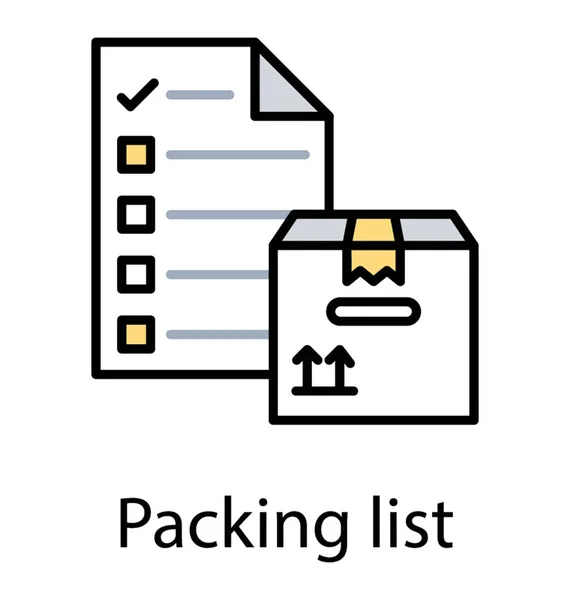Shipping documentation plays a crucial role in international trade. Among the key documents required for smooth logistics operations are the Packing List, Bill of Lading (B/L), and Commercial Invoice (CI). While these documents may seem similar, they serve distinct purposes in the supply chain. Understanding their roles and differences is essential to ensure compliance, avoid delays, and facilitate seamless customs clearance.
This guide explores what a packing list is, its components, and how it differs from a Bill of Lading and Commercial Invoice. We also provide tips for accurate and efficient documentation to help businesses streamline their shipping processes.

What Is a Packing List?
A Packing List is a detailed document that outlines the contents of a shipment. It is prepared by the exporter and serves as a reference for the carrier, freight forwarder, and customs authorities. The packing list provides vital information about the shipment’s items, ensuring accurate handling, identification, and compliance with shipping regulations.
Key Components of a Packing List
Exporter and Importer Details: Names, addresses, and contact information.
Shipment Details: Description of goods, quantity, weight, and dimensions.
Packaging Information: Type of packaging (e.g., pallets, boxes), number of packages, and volume.
Marks and Numbers: Identifying labels or markings on the packages.
Reference Numbers: Invoice numbers or purchase order references.
Special Instructions: Handling requirements, such as “Fragile” or “Keep Dry.”
Importance of a Packing List
Facilitates Customs Clearance: Customs officials use the packing list to verify the shipment’s contents against the invoice and other documents.
Ensures Accurate Delivery: Carriers and freight forwarders rely on the packing list to ensure proper handling and delivery of goods.
Prevents Shipping Errors: By detailing the shipment’s contents, the packing list minimizes the risk of missing or mismatched items.
What Is a Bill of Lading (B/L)?
A Bill of Lading (B/L) is a legal document issued by the carrier to the shipper. It serves as a contract of carriage, a receipt for the goods, and a document of title. The B/L outlines the terms and conditions of the shipment and is crucial for transferring ownership of the goods.
Key Functions of a B/L
Proof of Shipment: Confirms that the carrier has received the goods for transport.
Contract of Carriage: Defines the terms and responsibilities of the shipper and carrier.
Document of Title: Allows the consignee to claim ownership of the goods upon delivery.
Types of Bills of Lading
Straight B/L: Non-negotiable; used when goods are shipped directly to the consignee.
Order B/L: Negotiable; allows the transfer of ownership through endorsements.
Clean B/L: Indicates that the goods were received in good condition.
Claused B/L: Notes discrepancies, such as damaged or missing goods.
What Is a Commercial Invoice (CI)?
A Commercial Invoice (CI) is a document prepared by the exporter that provides a detailed account of the transaction between the buyer and seller. It is a financial document used for customs clearance and payment purposes.
Key Components of a CI
Exporter and Importer Information: Names, addresses, and contact details.
Invoice Number and Date: Unique identifier for the transaction.
Description of Goods: Detailed information about the products, including HS codes.
Unit Price and Total Value: Pricing details and overall transaction value.
Payment Terms: Terms of payment, such as “Net 30 Days” or “Letter of Credit.”
Shipping Terms (Incoterms): Specifies responsibilities for costs and risks (e.g., FOB, CIF, DDP).
Importance of a CI
Customs Clearance: Customs authorities use the CI to determine duties and taxes.
Proof of Sale: Serves as a formal record of the transaction.
Facilitates Payment: Used by financial institutions for payment processing.
Differences Between a Packing List, B/L, and CI
| Aspect | Packing List | Bill of Lading (B/L) | Commercial Invoice (CI) |
|---|---|---|---|
| Purpose | Details the shipment’s contents | Contract of carriage, proof of shipment | Financial document for customs and payment |
| Legal Document | No | Yes | No |
| Used By | Customs, carrier, buyer | Carrier, consignee, financial institutions | Customs, buyer, financial institutions |
| Focus | Shipment details | Transport terms and conditions | Transaction and pricing details |
| Role in Customs | Verifies shipment contents | Supports logistics documentation | Calculates duties and taxes |
Best Practices for Preparing Shipping Documents
1. Ensure Accuracy
Double-check all information, including product descriptions, quantities, and dimensions, to avoid discrepancies between documents.
2. Use Standard Formats
Adhere to industry-standard templates for packing lists, B/Ls, and CIs to ensure clarity and compliance.
3. Collaborate with Freight Forwarders
Work with experienced freight forwarders to streamline documentation and ensure all required details are included.
4. Include Consistent Information
Ensure that the information on the packing list, B/L, and CI matches to prevent delays or rejections during customs clearance.
5. Keep Records
Maintain copies of all shipping documents for reference and compliance audits.
How Tonlexing Simplifies Documentation
At Tonlexing, we specialize in providing end-to-end logistics solutions, including documentation assistance for international shipping. Our services include:
Packing List Preparation: Comprehensive and accurate packing lists tailored to your shipment.
Bill of Lading Management: Streamlined B/L issuance and tracking.
Commercial Invoice Support: Guidance on creating compliant and detailed invoices.
Customs Clearance Services: Ensuring all documents meet regulatory requirements for smooth clearance.
Whether you’re shipping to the USA, Europe, or Asia, Tonlexing ensures seamless documentation and logistics management to save you time and effort.
A Packing List, Bill of Lading, and Commercial Invoice are essential documents in international shipping, each serving a unique purpose. The packing list ensures accurate shipment details, the B/L serves as a legal contract and proof of shipment, and the CI facilitates customs clearance and payment processing.
By understanding the differences and roles of these documents, businesses can enhance their shipping efficiency and compliance. Partnering with reliable freight forwarders like Tonlexing further simplifies the process, ensuring that your goods reach their destination without delays or complications.
Contact Tonlexing today to streamline your shipping documentation and optimize your international logistics.


